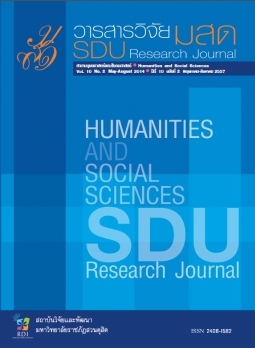Petitioning for the Geographical Indication (GI) Symbol Usage on “Trang Roast Pork” Manufacturing Process
Keywords:
Geographical Indicatio, Trang Roast PorkAbstract
“Trang Roast Pork” is Trang Province’s unique product which has a special manufacturing process informed by Trang’s local wisdom. The materials or
ingredients for “Trang Roast Pork” manufacturing process are from the local areas. “Trang Roast Pork” signature characteristics are pork skins that are crackling,
golden yellow, aromatic, tasty and full flavored. Trang Province has registered “Trang Roast Pork” as a Geographical Indication Product or GI in 2005. According to Thailand’s Geographical Indication Protection Act B.E. 2546 (2003), “Trang Roast Pork” manufacturers, who have roast pork manufacturing processes and comply with the Geographical Indication Handbook, have the right to apply for the usage of the Geographical Indication (GI) symbol in order to protect the “Trang Roast Pork” producers and consumers, maintain the uniqueness and standards, add value to “Trang Roast Pork”, create consumers’ confidence and increase the trade benefits against unfair trade and competitiveness.
References
name “Geographical Indication: GI”. Sukhothai
Thammathirat Journal, 14(2), 102 – 113. Laodusit, W. (1998). Possible Approaches in the Protection of Geographical Indication Under Trips Agreement in the Case of Thailand. Sukhothai Thammathirat Journal 10 (1), 102 – 113. Laodusit, W. (2001). Law of Geographical Indication and wisdom Thailand. Sukhothai thammathirat journal 14 (3), 90-103. Nakban, S., Nuwongsri, S., Sapbua, D. & Thorarit, T. (2014). Audit reports participants prepare for internal control roasted pork products 2014. Trang: Suan Dusit
University. Noinalum, K. (2008). Using a geographical indication to
protect their value added of trade in agricultural
products: case of Jasmine rice, Thailand. Journal of Ramkhamheang 25, 242-254.
Office of Commercial Affairs Trang (2016). List of operators selling roasted pork. Trang Province. Phaiputh, W. (2010). An Assessment of Consumers Willingness to Pay for Thai Geographical Indication Goods.
(Master’s Thesis). Bangkok: Kasetsart University. Research group of biodiversity; Bureau of Animal Husbandry and Genetic Improvement; Department of Livestock development. (2014). Thai local pigs. Retrieved July 12, 2016, from http://breeding.dld.go.th/biodiversity/ e-learning57/สุกรพันธุ์พื้นเมือง. Rules of DIP. (2008, May, 2). Allow for “THAI GEOGRAPHICAL INDICATION”. Sirisatian, N. & Ratrasan, S. (1965). Comparative study on growth of local piglets and hybrid. The 4th Agriculture and biological Symposium: Plant and biology and Animal branch 27-29 January 1965.
The board member of Celebration on the Auspicious occasion of His Majesty’s the king. (2001). The Culture
Historical Development Identity and Wisdom, Trang Province. Bangkok: Kurusapa Printing Ladphrao. Ubonlerskul, M. (2012). Efficiency of Sang Yod rice product under Geographical indication system. The 50th
Kasetsart symposium: Education Economic Business Administration Humanities and social science Branch. Udomprasert, P. (1999). Health management and productivity in pig farm. Bangkok: Kasetsart University. Wongsa, A. (2005). Genetic Diversity of Thai Native Pigs. Bangkok. (Master’s Thesis). Bangkok: Kasetsart
University. Yunchalad, M., Supasri, R., Stonsaovapak, S., Puminat, W. & Sarikaphuti, N. (2005). Production and preservation of roasted pork products. Proceedings of 43rd Kasetsart University Annual Conference: Animals, Agro-Industry.








